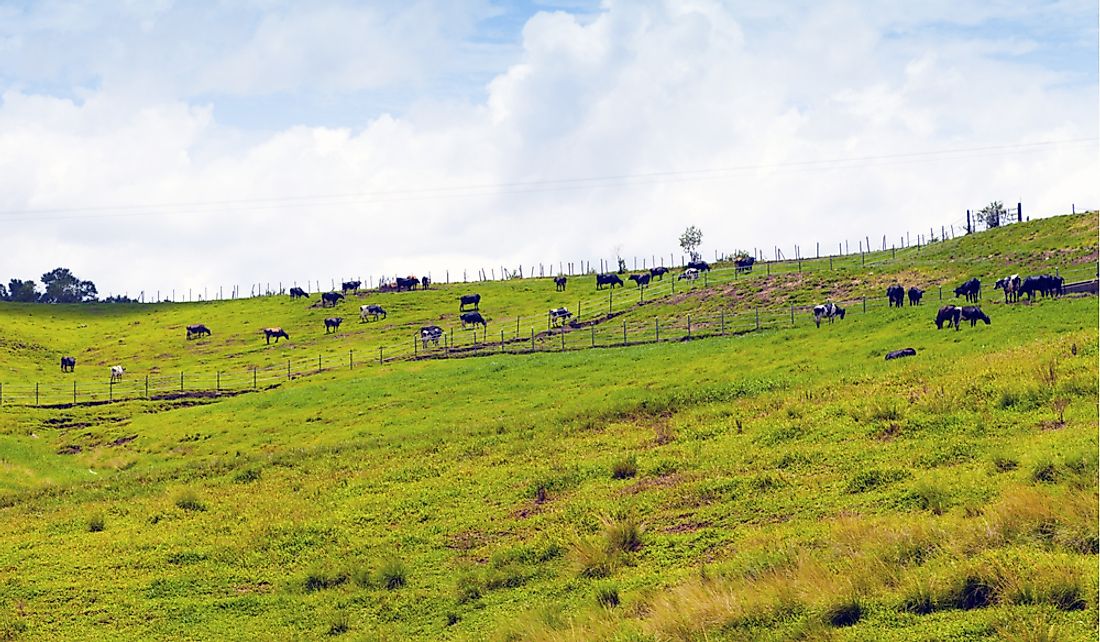What Are The Major Natural Resources Of Puerto Rico?

Puerto Rico is a 3,515 square mile nation that is considered to be an unincorporated territory of the United States. Information from the World Bank indicates that in 2016, Puerto Rico's Gross Domestic Product was valued at approximately $105 billion. Due to the region's high prosperity, the World Bank considers it to be one of the world's high-income economies. Several factors contribute to Puerto Rico's prosperity such as its geographical position and its political relationship to the US. Despite its economic prosperity, Puerto Rico is not considered to have a wealth of natural resources. The government of Puerto Rico has set up an agency, the Department of Natural and Environmental Resources of Puerto Rico, to ensure proper management and utilization of the region's limited natural resources. The department was established to replace the Department of Natural Resources of Puerto Rico.
Natural Resources of Puerto Rico
Arable Land
Arable land is one of Puerto Rico's most important natural resources. Despite its importance, only 6% of the region's total area is considered arable. Experts believe that the low amount of arable land could pose a huge challenge to attaining food security. To ensure constant food security, the Puerto Rican government is forced to import vast quantities of food each year. Some of the main crops grown in the region include avocados, mangos, and grapefruits. According to official government records, the agricultural sector in Puerto Rico accounts for slightly less than 1% of the region's gross domestic product. Some estimates indicate that in 2013, agriculture contributed close to $808,000,000 to the gross domestic product.
Puerto Rico faces some challenges in achieving full utilization of its agricultural potential such as a low number of people willing to work in the agricultural sector as well as poor agricultural practices. The sectors’ insufficient workforce has been attributed to some factors such as the increased emphasis on industrial jobs as well as unwillingness in the Puerto Rican youth to work in the agricultural sector. Some studies indicate that the main agricultural workforce in Puerto Rico, roughly 65% according to some figures, is comprised of people who are over 55 years old. Puerto Rico's agricultural industry is also adversely affected by the constant hurricanes in the region. Experts believe that if the present challenges are addressed, Puerto Rican agriculture could satisfy as much as 30% of the local agricultural demand.
Livestock
Another of Puerto Rico's significant natural resources is the livestock. Some of the most commonly kept animals in the region include pigs, rabbits, cattle, horses, and donkeys. Even though donkeys, mules, and horses are widespread on the island, the locals do not consume them due to cultural taboos. Cattle are the most important of the livestock kept in Puerto Rico since it supplies the locals with both meat and milk. Puerto Rico's milk industry is one of the island's most essential industries as the island is considered to be relatively self-sufficient regarding milk production. There are a couple of milk processing factories on the island with the most prominent ones being Tres Monjitas and Suiza Dairy. Poultry keeping is also important in Puerto Rico with some of the most commonly kept birds being ducks, quails, and chickens. The livestock industry in Puerto Rico faces some challenges chief among them being the constant devastating hurricanes experienced in the area.
Fish
Fish is one of Puerto Rico's most important natural resources due to its location in the Atlantic Ocean. Some of the main fish species consumed by the Puerto Rican people include tuna, trunkfish, marlin, and snapper.
Despite its importance, experts believe that the natural fisheries around the island cannot support a profitable fishing sector. The US government has set up an agency, the Caribbean Fishery Management Council, to manage Puerto Rico's fish resources. The government also allocates vast quantities of money to the Puerto Rican fishing sector to improve the industry. In 2018, according to an article in the Maritime Herald, $11.4 million was set aside for the Puerto Rican fishing sector.
Minerals
Different types of minerals can be found in Puerto Rico such as gold, copper, molybdenum, and silver. Despite the presence of valuable metal minerals in Puerto Rico, the deposits are not considered economically viable. A study carried out in 1998 estimated that the value of Puerto Rico's nonfuel minerals was approximately $252 million. At the time, the value of Puerto Rico's nonfuel minerals was the 39th highest in the US. Some of the essential nonfuel minerals at the time included Portland cement, sand, gravel, and crushed stone.
A recent study by the US government indicates that there are deposits of natural gas as well as oil off Puerto Rico's coast. The study was unable to determine if the oil and gas in Puerto Rico could be economically viable. The mining industry in the region faces some significant challenges such as insignificant urban planning as well as the poor management of the local terrain.
Beautiful Scenery
The island's natural scenery is one of Puerto Rico's most important natural resources. Puerto Rico's natural beauty attracts huge numbers of visitors most of whom are from the US. Apart from American citizens, most of the visitors to Puerto Rico are from nations such as Britain, France, Spain, and Mexico. Some of the most popular tourist attraction sites in Puerto Rico include Flamenco Beach and the city of Old San Juan.
Economy of Puerto Rico
Puerto Rico's economy faces some significant challenges such as an extremely high public debt, which is valued at 103% of the gross national product, and an extremely high budget deficit of approximately $2.5 billion. Puerto Rico's economy has been experiencing depression for roughly 12 years that began in 2006. Experts believe that Puerto Rico's economic downturn has been caused by some factors such as the highly political nature of its public policy as well as mismanagement by the local government.











